NW11 is Golders Green and Hampstead Garden Suburb. And the eagle eyed amongst you will have spotted that this breaks the general rule about the names of the post code districts being in alphabetical order. I guess the reason was that this was probably part of NW3 or perhaps even NW2 when the numbers were first allocated, but got its own number later.
We start out walk at the Post Office at Number 879 Finchley Road, Golders Green. Turn right out of the Post Office and our first stop is a little way down the road on the other side.
Stop 1: Number 612 Finchley Road
This dull looking Sainsburys supermarket is on the site of the Ionic cinema which was built in 1913.
As the name suggests it had a greek style facade. Here is a picture from the wonderful Cinema treasures site:
http://cinematreasures.org/theaters/26434
Sainsbury’s bought the site for development in the early 1970s. The planners did try to secure a cinema in the new building and in fact one was included – opening in 1975. It carried on to 1999 and it seems the space is still there, but obviously not used a cinema. Here is a picture of the “new” Ionic cinema when it was operated by Cannon.
http://cinematreasures.org/theaters/6290
So now that big white space on the facade makes sense.
Now return along Finchley Road and at the main junction by the war memorial turn right. Our next stop is just over the road
Stop 2: Golders Green Hippodrome
Interestingly the Golders Green Hippodrome was also built in 1913. Designed by renowned theatre architect Bertie Crewe, it started as a music hall with some 2,245 seats on three levels.
It became famous as a try out pre West End venue. I see from Kenneth Williams Diaries that he appeared here in February 1965 in the fated first run of Joe Orton’s play Loot. The play went on to Bournemouth, Manchester and Wimbledon where the run ended before it got to the West End. But it was revived successfully the following year and went to Broadway in 1968, after Orton’s death.
The theatre was taken over by the BBC in 1968, initially as a television studio and then from 1972, it was used as a radio concert venue. The audience was seated in the rear stalls and the circle, with the upper circle closed off.
The BBC Concert Orchestra made the theatre their home and for many years the popular ‘Friday Night is Music Night’ programme was broadcast live, in front of an audience. The BBC moved out of the Grade II listed building in December 2005.
It was bought by El Shaddai International Christian Centre. A condition of the sale was that some live entertainment should be provided. It does not seem to have much theatrical use (unless church services count) although it appears there is an African Comedy show once a month on a Friday.
Our next stop is just next door.
Stop 3: Golders Green Station
The tube is why Golders Green is here. In 1907, Golders Green consisted of just a handful of houses, but the arrival of the railway lead to the whole area being developed.
Golders Green station was opened by the Charing Cross, Euston & Hampstead Railway (CCE & HR) in June 1907. This was one of the three lines built by Charles Tyson Yerkes whose stations have the distinctive dark red tiles. Golders Green was one of the CCE & HR’s two northern terminals – the other being at Archway. It was also the location of the railway’s depot.
Interestingly this station does not have the standard red tiles. Maybe it never did as it was an above ground station or else this feature was lost when the station was rebuilt later.
Before the First World War plans were made to extend the line north from Golders Green to Hendon and Edgware. But the war intervened and work did not begin until 1922.
The station has an odd layout with five platforms but only three tracks. So platforms 1 and 2 serve one track.; platforms 3 & 4 serve another, whilst platform 5 serves the third. Morden also has this strange arrangement and like Morden, Platform number 1 is not in public use.
Leave the station forecourt and turn right under the railway and continue along Finchley Road. Turn right at the traffic lights into Hoop Lane. Our next stop is just ahead.
Stop 4: Golders Green Crematorium
Cremation was not legal in Great Britain until 1885. The first crematorium was built in Woking and it proved a success. At that time cremation was championed by the Cremation Society of Great Britain. Out of this Society was formed the London Cremation Company which built this one – the first crematorium to be opened in London. The land for the crematorium was purchased in 1900 and the crematorium was opened in 1902.
This is a very striking set of buildings and unlike most crematoria, they are not hidden away in a parkland but are hard on the road with the memorial garden areas behind.
A veritable who’s who of well known people have been cremated at Golders Green. Wikipedia has a list: http://en.wikipedia.org/wiki/Golders_Green_Crematorium
Across the road is a cemetery. But it is somewhat unusual as for a substantial part the gravestones lie flat on the ground. This is because it is a Sephardic Jewish cemetery
And there does not seems to be any planting which makes for a very stark outlook.
Continue along Hoop Lane. At the end go through the little garden with the archway and into Meadway, which is our first sight of Hampstead Garden Suburb. Our next stop is just on the right.
Stop 5: Number 8 Meadway
This was the home of Robert Donat (1905 – 1958). He only made about twenty films in the 1930s and 1940s but a couple of these mean he is not totally forgotten.
He played the part of Richard Hannay in Hitchcock’s 1935 film “The 39 Steps” and he was also the school teacher in the 1939 film “Goodbye Mr Chips”. For this latter part he won an Oscar for Best Actor, which is pretty incredible given that the competition included Clark Gable as Rhett Butler in Gone with the Wind and Lawrence Olivier as Heathcliffe in Wuthering Heights.
This house is unusual in that most of the houses in Hampstead Garden Suburb have retained their front gardens with their hedges. For some reason Number 8 seems to have been allowed a paved standing and has lost most of its hedge.
Continue along Meadway and turn right into Heathgate. This strangely does not have a pathway after a while and you are forced to walk in the road.
As you get to the end of Heathgate have a look back to see one of the vistas which are part of the design of Hampstead Garden Suburb.
We are now at the edge of the Heath – or perhaps more accurately the Hampstead Heath Extension. It was the preservation of this land as open space which meant that the station which had been planned near the Old Bull and Bush was not built, as we heard in NW3.
And just here at this edge of the heath is an unusual feature. It is called the Great Wall.
Stop 6: The Great Wall
Pevsner describes the Great Wall as picturesquely dividing the heath from the gardens of the houses to its north and in inspiration it is like a medieval town wall but punctuated with Lutyenish pavilions rather than conventional bastions. Only the western half of the planned wall was actually built.
Now you have a choice. Either go onto the heath, turn left and walk along the edge and turn right when you get to the road (Wildwood Road) or else if you do not want to get muddy return to Meadway and turn right and then go right into Wildwood Road. Our next stop is on Wildwood Road just past the little roundabout on the right.
Stop 7: Number 15 Wildwood Road
This lovely house was the home of Frank Pick (1878 — 1941).
He trained as a solicitor. Initially he worked for the North Eastern Railway, then he moved to Underground Electric Railways Company of London (UERL) in 1906. At UERL he rose through the corporate ranks, picking up responsibilities for marketing and traffic development.
Pick, together with UERL General Manager, Albert Stanley, devised a plan to increase passenger numbers: developing the “UNDERGROUND” brand and establishing a joint booking system and coordinated fares throughout all of London’s underground railways, even the lines not controlled by UERL .
Pick became joint assistant managing director in 1921 and managing director in 1928. When the new London Passenger Transport Board was created in 1933, he was its first chief executive officer and also vice-chairman.
Pick had a strong interest in design and its use in public life. He understood the need for a strong corporate identity for the Underground in advertising and signage using the first versions of the now familiar “roundel” and the Johnson typeface – a version of which is still used today. He also commissioned bold new station buildings, which have stood the test of time. Under his direction, the Underground and associated bus services expanded considerably and stimulated the growth of London’s suburbs.
An interesting citation on the plaque, don’t you think?
Keep walking along and our next stop is just a little further on across the road.
Stop 8: Number 48 Wildwood Road
This was the home of Dame Myra Hess (1890 – 1965). Hess was a concert pianist and is perhaps best remembered for organising lunchtime concerts during World War II when the concert halls were blacked out at night to avoid being targets of German bombers. She organised some 1700 lunchtime concerts over a period of six years. The concerts were held at the National Gallery, in Trafalgar Square; Hess herself played in 150 of them. For this contribution to maintaining morale she was given the honour of Dame Commander of the British Empire in 1941.
Now retrace your steps along Wildwood Road. As we walk along Wildwood Road, note the little close on the right, called Raeburn Close.
I was struck by the two benches placed either side of this little close.
No idea about who this couple were or what they did but their names live on with these benches.
Continue walking along Wildwood Road and turn right into Meadway. Take the second turning on the right.
Stop 9: Number 10 Grey Close
This was the home of legendary comedian Tony Hancock (1924 – 1968) in 1947 and 1948 and is commemorated by a plaque from the Dead Comic’s Society.
He had a major success with his BBC series Hancock’s Half Hour – first on radio from 1954 and then on television from 1956. His scriptwriters in the 1950s were Ray Galton and Alan Simpson but once he broke with them in 1961, this was the beginning of the end.
Return to Meadway and cross over into Lichfield Way, taking the first turning on the left (Southway). As this road turns, you get another vista of St Jude’s Church.
When you get to the end turn right and then left into Central Square.
Stop 10: Central Square
This is the centrepiece of Hampstead Garden Suburb.
The Suburb was founded by social reformer, Henrietta Barnett at the beginning of the 20th Century. In the 1880s, she and her husband Samuel, an ordained Minister, had sown the seeds of the Whitechapel Art Gallery and established Toynbee Hall, a social reform charity working to bridge the gap between people of all social and financial background.
In 1906, Barnett set up the Hampstead Garden Suburb Trust Ltd, which purchased 243 acres of land from Eton College and appointed Raymond Unwin as its architect. The Suburb was inspired by the garden city movement of Ebenezer Howard and aimed to provide a development which catered for all classes of people and all income groups in low density housing with woods and gardens which were free to all. However unlike a Garden City, it was never envisaged that there would be any factories or other commercial developments to provide employment for the inhabitants.
Central Square has three set pieces around a green. We have already seen St Jude’s church which stands on the south side of the square. Then there is another church – a “free” church on the north side and finally on the east side is an educational building, now Henrietta Barnett school. The fourth side is looks rather unfinished with some decaying tennis courts.
I thought the dedication of the C of E church to St Jude was an interesting choice for the social reformers behind the suburb. He is after all the patron saint of lost causes. But I guess the reason for this dedication was that St Jude’s was Cannon Samuel Barnett’s church in Whitechapel.
The church is by Lutyens. Here is a link to the Church website which has a comprehensive history.
http://www.stjudeonthehill.com/2010/02/guide-to-st-judes.html
The initial plans for the suburb included shops on the approaches to the sqaure, but this were omitted in the final build. In fact there are no commercial building as far as I could see in this part of the suburb. This means it is somewhat lifeless.
Pevsner puts this delightfully “Institute education and divine worship have not proved to be much of a lively attraction as the social reformers hoped for”
There are two reminders of Dame Henrietta. First is a monument – a rather strange affair of a pillar in the centre of an archway of metal. It looks like there is something missing from atop the pillar – maybe a sundial or a statue.
The other is at the first house in South Square – that is to the right of the church as you look at it from the monument. If you go to this house (which is Number 1, South Square) you will see a memorial plaque to Dame Henrietta showing she lived here from 1915 to 1939.
Now retrace your steps to Central Square and go out the other end (past the non-conformist church)
Looking back you get some nice views of these set piece buildings.
Turn down Erskine Hill ( which is the road opposite the entrance to the church driveway). At the cross roads turn left into Temple Fortune Hill. Continue along this until the end and then turn right into Hampstead Way. Our next stop is just ahead as the road turns to the right.
Stop 11: Numbers 140 & 142 Hampstead Way
These two houses were the first to be completed in Hampstead Garden Suburb
This was the first part of Hampstead Garden Suburb to be developed and it was intended for artisans and workers. I doubt there are too many “artisans and workers” living in these houses today.
Continue walking along Hampstead Way to the end and turn right into Finchley Road. Take an opportunity to look back at this junction as it was (according to Pevsner) intended to the the main gateway to the suburb – its Germanic silhouettes inspired by medieval towns.
Walk a little way along Finchley Road and our final stop is on the right.
Stop 12: Birnbeck Court and the Pantiles
Birnbeck Court is built on the site of the Orpheum Theatre, later the Odeon Temple Fortune.
The Orpheum Theatre opened in October 1930 with full stage facilities. Initially it was independently operated and had a mixed programme of cinema and live variety. It changed hand a couple of times and was finally taken over by Oscar Deutsch’s Odeon Theatres Ltd. in 1937. It was re-named Odeon in 1945, initially known as the Odeon Temple Fortune but later the Odeon Golders Green.
The Odeon was closed in April 1974 It lay empty and unused for many years, eventually being demolished in May 1982, to be replaced by this housing development.
Sadly this temple of the 1930s is no longer with us, but we can get a glimpse of Hollywood in the magnificent Deco block of flats next door. This is called The Pantiles and dates from 1935. It has these distinctive green roof tiles which evoke this period.
So that brings us to the end of our NW11 walk. Hampstead Garden Suburb is lovely but it is a little sad that the vision did not quite work out. However if there had been shops around the Central Square, they are unlikely to be serving the community’s everyday needs today. Most likely they would be exclusive specialist shops for designer clothes and trinkets, with artisan bakers and the like. So maybe it turned out for the best after all.
For onward travel probably best to catch a bus back to Golders Green (Numbers 82, 102 and 460)

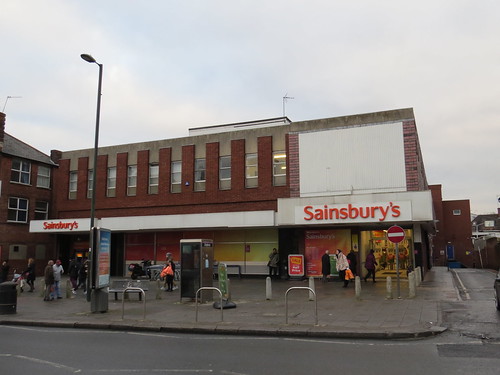

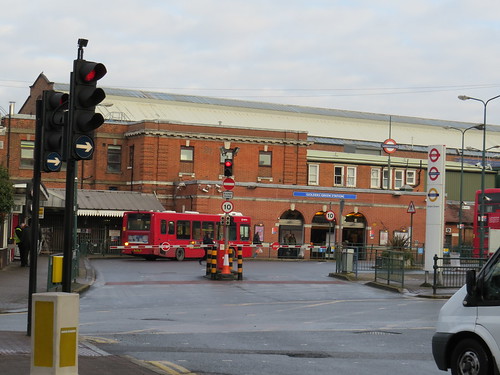









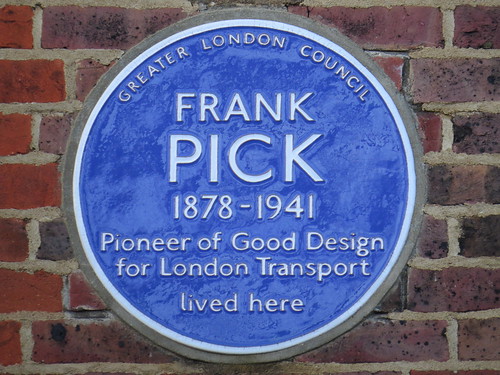



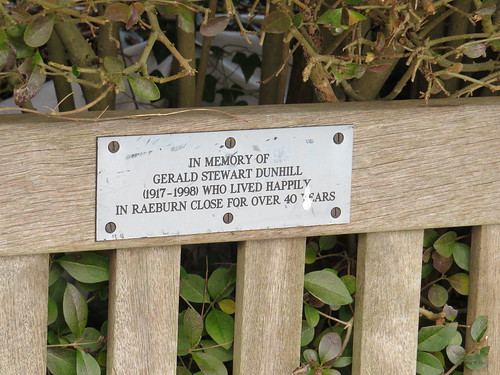


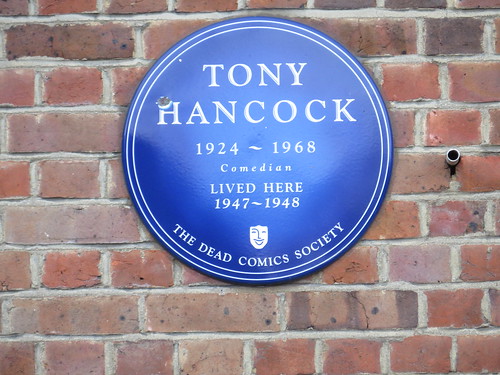
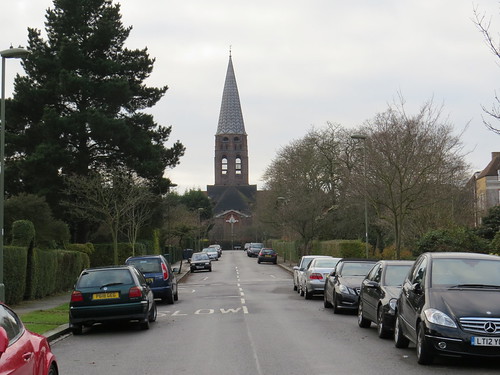

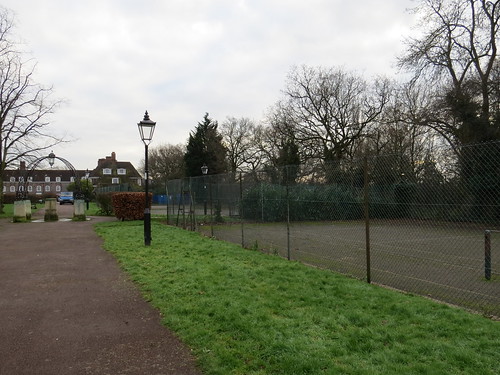

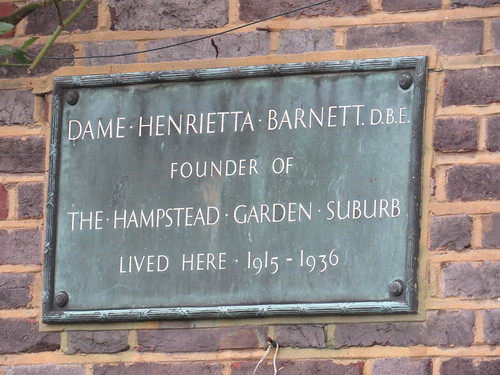

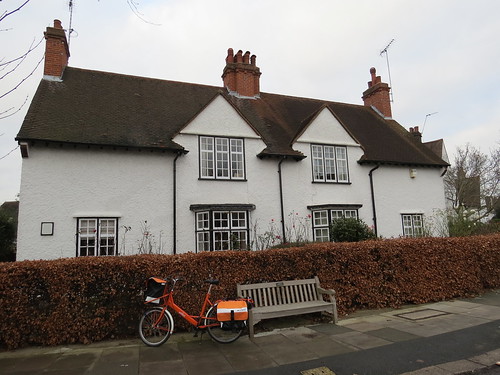
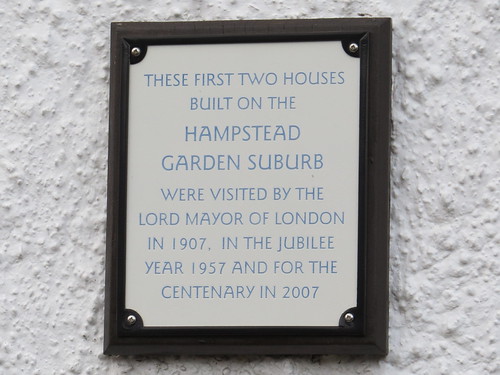


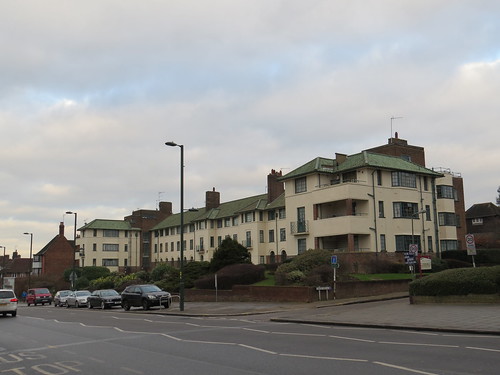
Again, thank you for this walk. I was brought up in the ’40s, 50s in this area, near to 140 Hampstead Way. Visited the Odeon cinema, watching cowboy films with friends on wet Saturday afternoons. Harold Wilson (once P.M. of HM Government) lived in Southway (is there a blue plaque?). Was in a Cub pack with one of his sons. Saw Harold walk to the Finchley Road shops to buy his pipe tobacco, but there was no police protection for him; how things have changed!
I love reading your blog and it always makes me very sentimental 🙂 Can´t wait to go back to London to explore some of the places you´re writing about.
But wasn´t it Clarke Gable rather than Erol Flynn who played Rhett Butler in “Gone with the wind”?!
Thanks for your comments. Glad you are enjoying the blog. Yes you are quite right about Gone with the Wind. I will correct that.
Interesting to see from an insider who gives Suburb walks to see an outsiders view and what you select